Business Report: Analysis of RAC Motoring Services Operations
VerifiedAdded on 2020/02/05
|10
|2286
|56
Report
AI Summary
This report provides an in-depth analysis of RAC Motoring Services' operational challenges, focusing on its declining market share due to increased competition and customer service issues. The study examines RAC's operational strategy, including its patrol force, dispatching system, and use of private contractors. It identifies factors contributing to poor customer service, such as inefficient patrol work and the use of less-equipped contractors. The report includes a process map illustrating the customer service journey. Recommendations are provided to improve RAC's operations, such as offering incentives to patrols during peak hours to boost productivity and reduce contractor usage. The conclusion emphasizes the need for RAC to enhance customer service quality and regain its market share by optimizing operational strategies and employee incentives. The report references various academic sources to support its findings and recommendations.
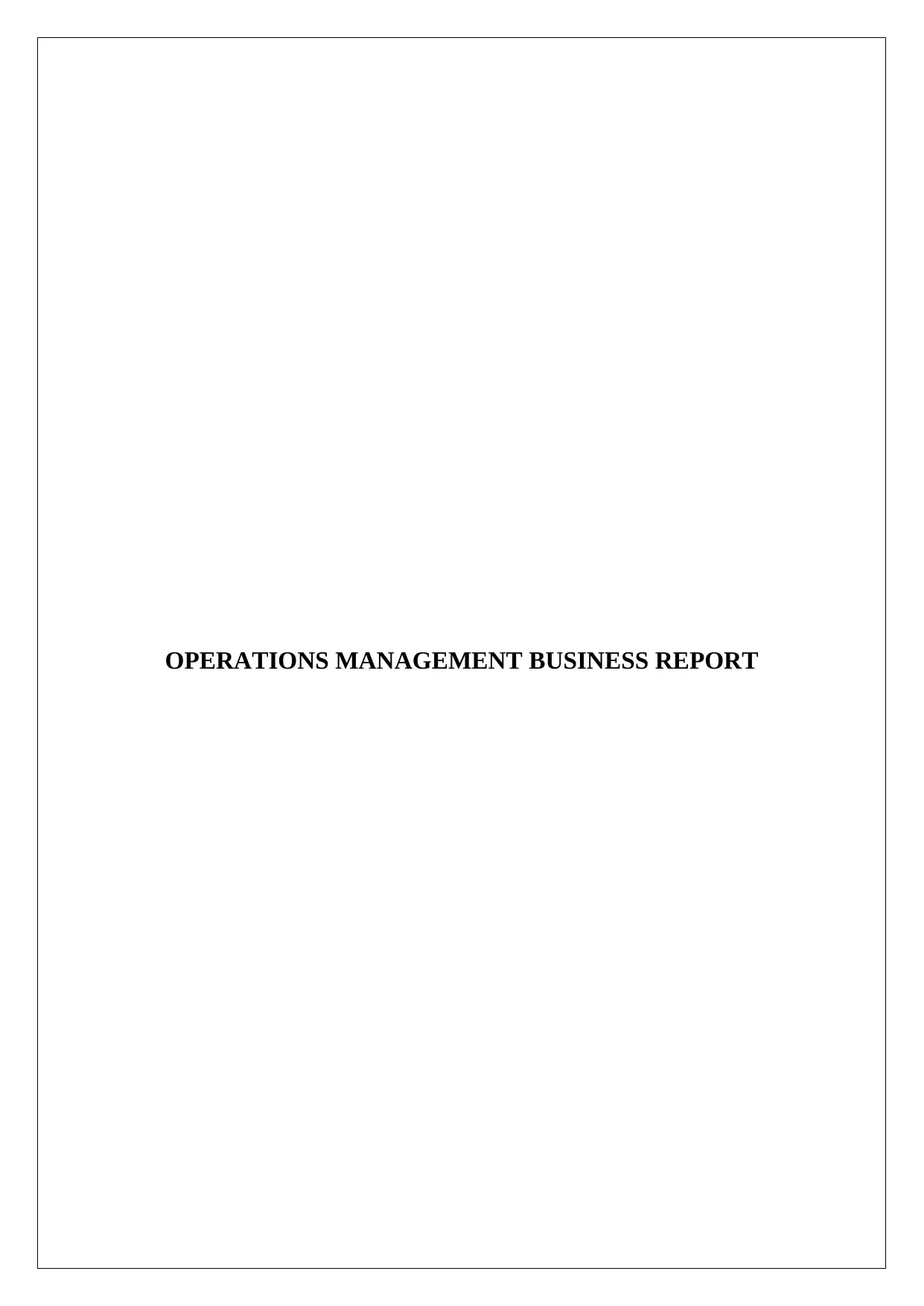
OPERATIONS MANAGEMENT BUSINESS REPORT
Paraphrase This Document
Need a fresh take? Get an instant paraphrase of this document with our AI Paraphraser
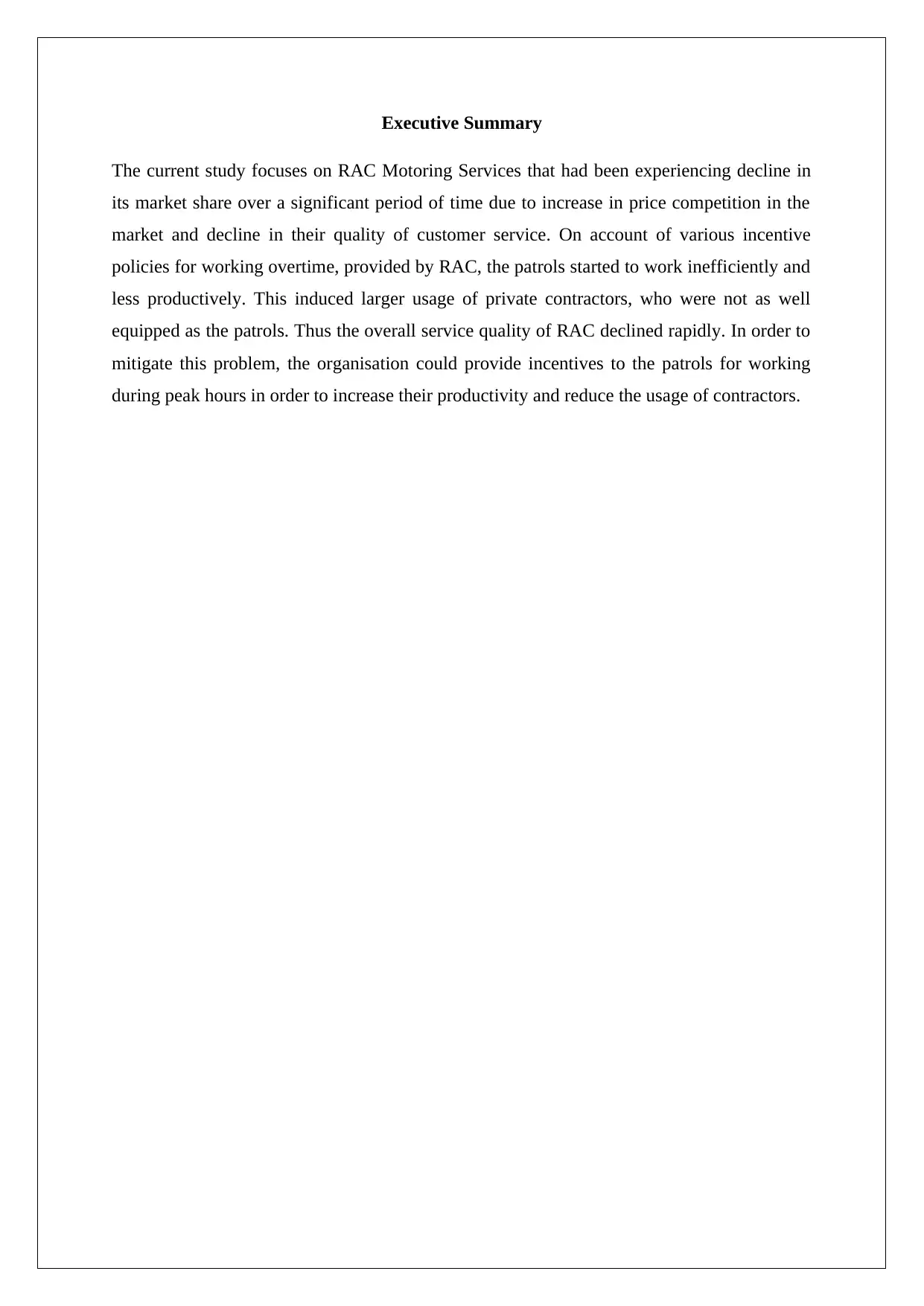
Executive Summary
The current study focuses on RAC Motoring Services that had been experiencing decline in
its market share over a significant period of time due to increase in price competition in the
market and decline in their quality of customer service. On account of various incentive
policies for working overtime, provided by RAC, the patrols started to work inefficiently and
less productively. This induced larger usage of private contractors, who were not as well
equipped as the patrols. Thus the overall service quality of RAC declined rapidly. In order to
mitigate this problem, the organisation could provide incentives to the patrols for working
during peak hours in order to increase their productivity and reduce the usage of contractors.
The current study focuses on RAC Motoring Services that had been experiencing decline in
its market share over a significant period of time due to increase in price competition in the
market and decline in their quality of customer service. On account of various incentive
policies for working overtime, provided by RAC, the patrols started to work inefficiently and
less productively. This induced larger usage of private contractors, who were not as well
equipped as the patrols. Thus the overall service quality of RAC declined rapidly. In order to
mitigate this problem, the organisation could provide incentives to the patrols for working
during peak hours in order to increase their productivity and reduce the usage of contractors.
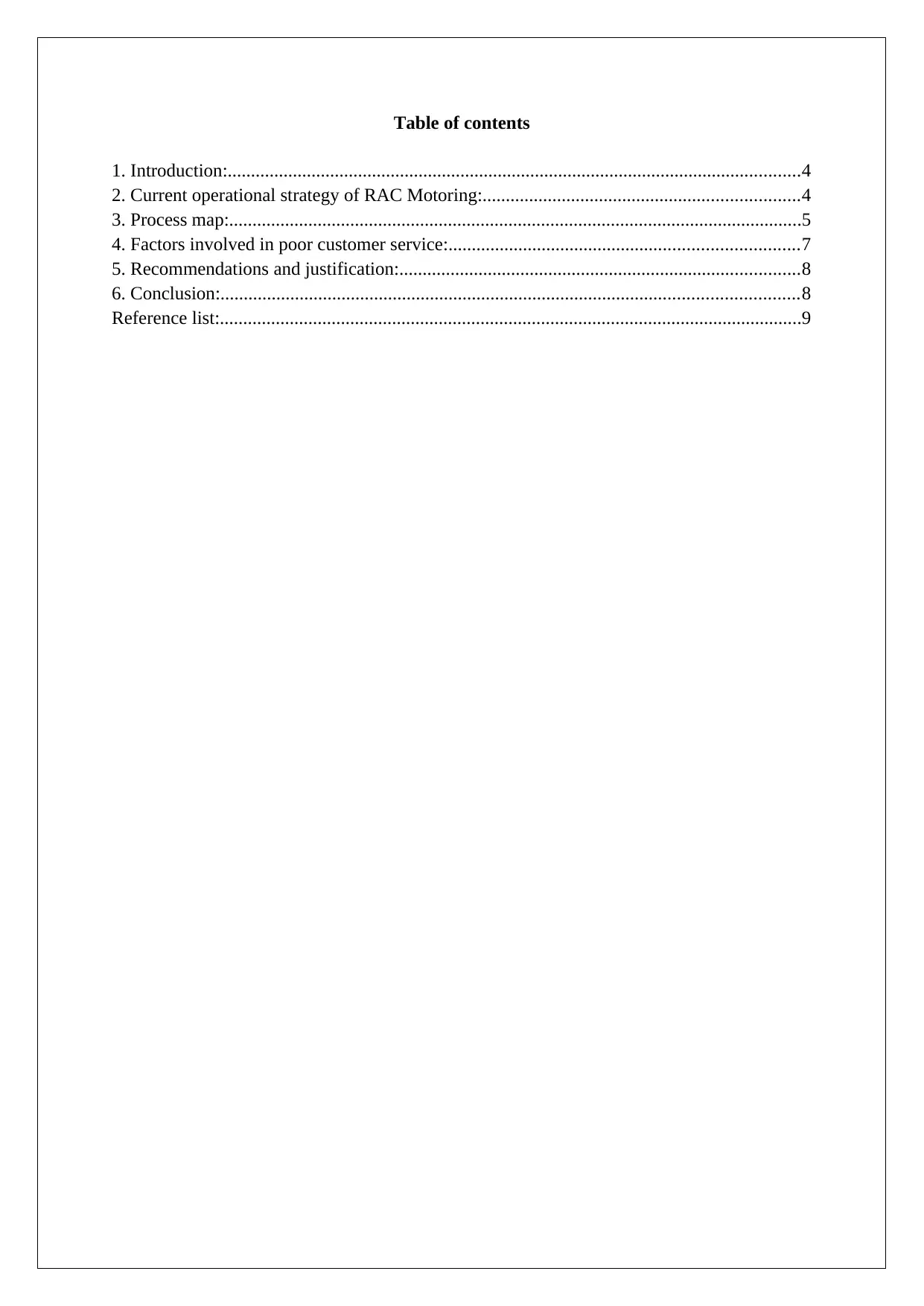
Table of contents
1. Introduction:...........................................................................................................................4
2. Current operational strategy of RAC Motoring:....................................................................4
3. Process map:...........................................................................................................................5
4. Factors involved in poor customer service:...........................................................................7
5. Recommendations and justification:......................................................................................8
6. Conclusion:............................................................................................................................8
Reference list:.............................................................................................................................9
1. Introduction:...........................................................................................................................4
2. Current operational strategy of RAC Motoring:....................................................................4
3. Process map:...........................................................................................................................5
4. Factors involved in poor customer service:...........................................................................7
5. Recommendations and justification:......................................................................................8
6. Conclusion:............................................................................................................................8
Reference list:.............................................................................................................................9
⊘ This is a preview!⊘
Do you want full access?
Subscribe today to unlock all pages.

Trusted by 1+ million students worldwide
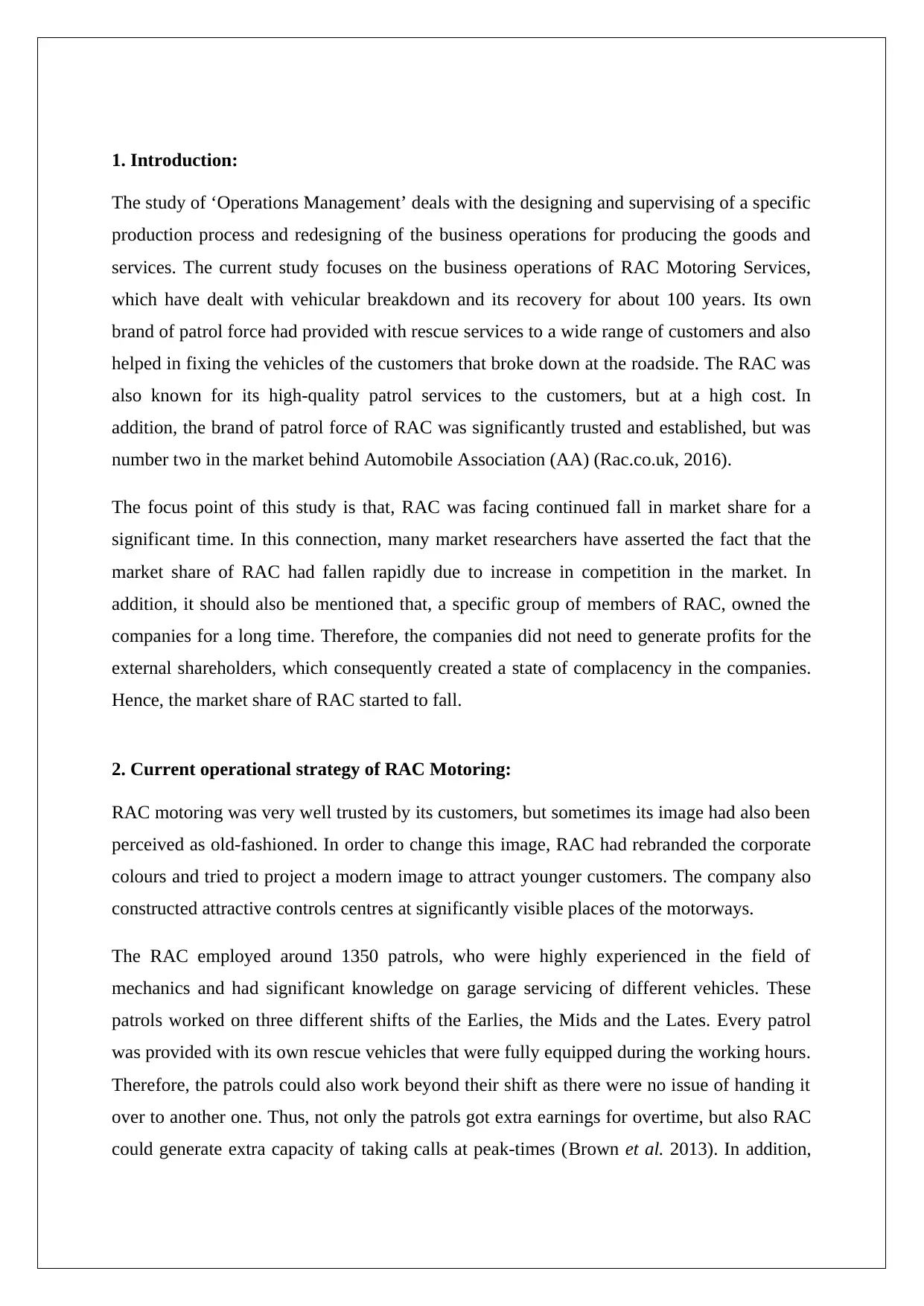
1. Introduction:
The study of ‘Operations Management’ deals with the designing and supervising of a specific
production process and redesigning of the business operations for producing the goods and
services. The current study focuses on the business operations of RAC Motoring Services,
which have dealt with vehicular breakdown and its recovery for about 100 years. Its own
brand of patrol force had provided with rescue services to a wide range of customers and also
helped in fixing the vehicles of the customers that broke down at the roadside. The RAC was
also known for its high-quality patrol services to the customers, but at a high cost. In
addition, the brand of patrol force of RAC was significantly trusted and established, but was
number two in the market behind Automobile Association (AA) (Rac.co.uk, 2016).
The focus point of this study is that, RAC was facing continued fall in market share for a
significant time. In this connection, many market researchers have asserted the fact that the
market share of RAC had fallen rapidly due to increase in competition in the market. In
addition, it should also be mentioned that, a specific group of members of RAC, owned the
companies for a long time. Therefore, the companies did not need to generate profits for the
external shareholders, which consequently created a state of complacency in the companies.
Hence, the market share of RAC started to fall.
2. Current operational strategy of RAC Motoring:
RAC motoring was very well trusted by its customers, but sometimes its image had also been
perceived as old-fashioned. In order to change this image, RAC had rebranded the corporate
colours and tried to project a modern image to attract younger customers. The company also
constructed attractive controls centres at significantly visible places of the motorways.
The RAC employed around 1350 patrols, who were highly experienced in the field of
mechanics and had significant knowledge on garage servicing of different vehicles. These
patrols worked on three different shifts of the Earlies, the Mids and the Lates. Every patrol
was provided with its own rescue vehicles that were fully equipped during the working hours.
Therefore, the patrols could also work beyond their shift as there were no issue of handing it
over to another one. Thus, not only the patrols got extra earnings for overtime, but also RAC
could generate extra capacity of taking calls at peak-times (Brown et al. 2013). In addition,
The study of ‘Operations Management’ deals with the designing and supervising of a specific
production process and redesigning of the business operations for producing the goods and
services. The current study focuses on the business operations of RAC Motoring Services,
which have dealt with vehicular breakdown and its recovery for about 100 years. Its own
brand of patrol force had provided with rescue services to a wide range of customers and also
helped in fixing the vehicles of the customers that broke down at the roadside. The RAC was
also known for its high-quality patrol services to the customers, but at a high cost. In
addition, the brand of patrol force of RAC was significantly trusted and established, but was
number two in the market behind Automobile Association (AA) (Rac.co.uk, 2016).
The focus point of this study is that, RAC was facing continued fall in market share for a
significant time. In this connection, many market researchers have asserted the fact that the
market share of RAC had fallen rapidly due to increase in competition in the market. In
addition, it should also be mentioned that, a specific group of members of RAC, owned the
companies for a long time. Therefore, the companies did not need to generate profits for the
external shareholders, which consequently created a state of complacency in the companies.
Hence, the market share of RAC started to fall.
2. Current operational strategy of RAC Motoring:
RAC motoring was very well trusted by its customers, but sometimes its image had also been
perceived as old-fashioned. In order to change this image, RAC had rebranded the corporate
colours and tried to project a modern image to attract younger customers. The company also
constructed attractive controls centres at significantly visible places of the motorways.
The RAC employed around 1350 patrols, who were highly experienced in the field of
mechanics and had significant knowledge on garage servicing of different vehicles. These
patrols worked on three different shifts of the Earlies, the Mids and the Lates. Every patrol
was provided with its own rescue vehicles that were fully equipped during the working hours.
Therefore, the patrols could also work beyond their shift as there were no issue of handing it
over to another one. Thus, not only the patrols got extra earnings for overtime, but also RAC
could generate extra capacity of taking calls at peak-times (Brown et al. 2013). In addition,
Paraphrase This Document
Need a fresh take? Get an instant paraphrase of this document with our AI Paraphraser
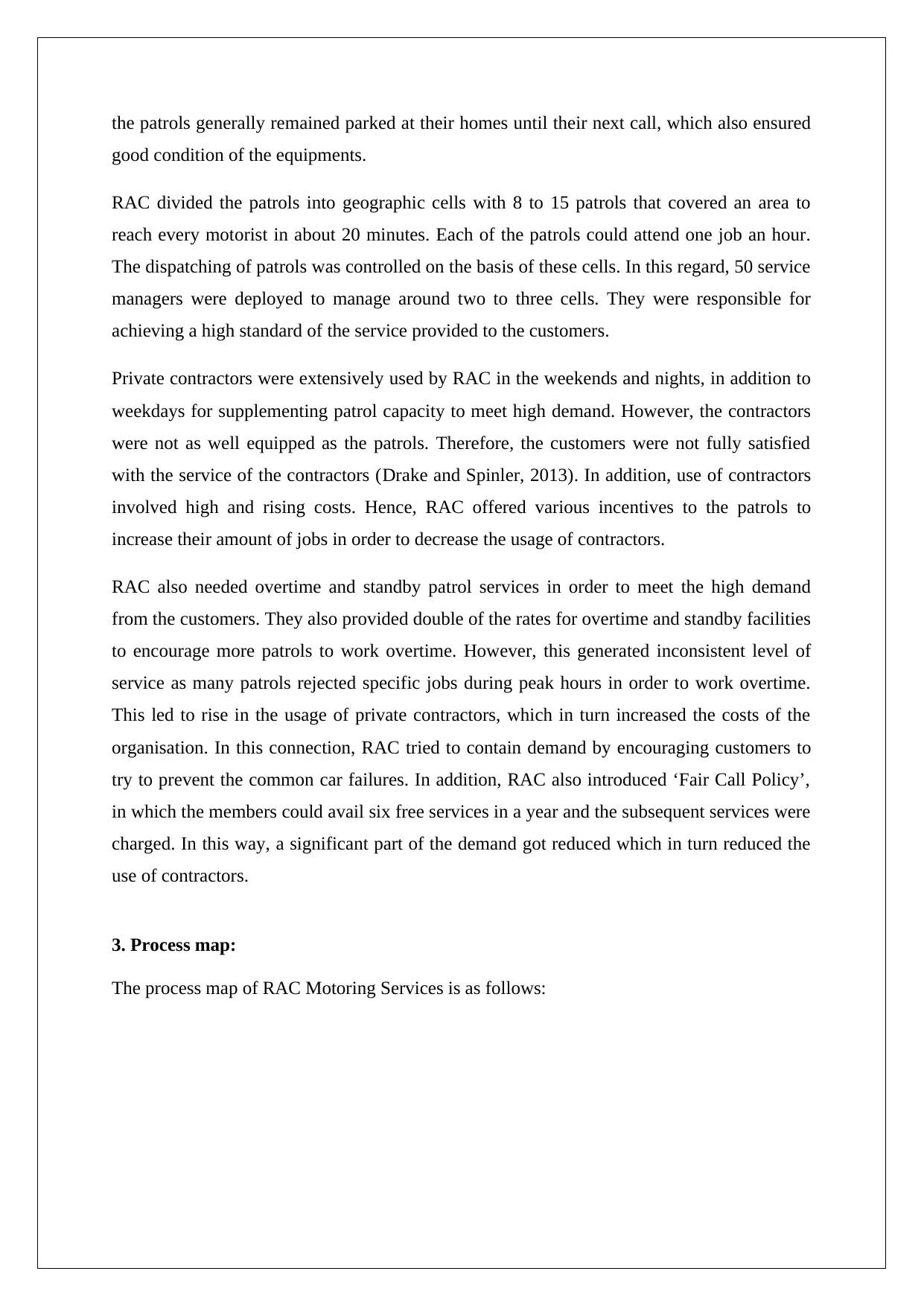
the patrols generally remained parked at their homes until their next call, which also ensured
good condition of the equipments.
RAC divided the patrols into geographic cells with 8 to 15 patrols that covered an area to
reach every motorist in about 20 minutes. Each of the patrols could attend one job an hour.
The dispatching of patrols was controlled on the basis of these cells. In this regard, 50 service
managers were deployed to manage around two to three cells. They were responsible for
achieving a high standard of the service provided to the customers.
Private contractors were extensively used by RAC in the weekends and nights, in addition to
weekdays for supplementing patrol capacity to meet high demand. However, the contractors
were not as well equipped as the patrols. Therefore, the customers were not fully satisfied
with the service of the contractors (Drake and Spinler, 2013). In addition, use of contractors
involved high and rising costs. Hence, RAC offered various incentives to the patrols to
increase their amount of jobs in order to decrease the usage of contractors.
RAC also needed overtime and standby patrol services in order to meet the high demand
from the customers. They also provided double of the rates for overtime and standby facilities
to encourage more patrols to work overtime. However, this generated inconsistent level of
service as many patrols rejected specific jobs during peak hours in order to work overtime.
This led to rise in the usage of private contractors, which in turn increased the costs of the
organisation. In this connection, RAC tried to contain demand by encouraging customers to
try to prevent the common car failures. In addition, RAC also introduced ‘Fair Call Policy’,
in which the members could avail six free services in a year and the subsequent services were
charged. In this way, a significant part of the demand got reduced which in turn reduced the
use of contractors.
3. Process map:
The process map of RAC Motoring Services is as follows:
good condition of the equipments.
RAC divided the patrols into geographic cells with 8 to 15 patrols that covered an area to
reach every motorist in about 20 minutes. Each of the patrols could attend one job an hour.
The dispatching of patrols was controlled on the basis of these cells. In this regard, 50 service
managers were deployed to manage around two to three cells. They were responsible for
achieving a high standard of the service provided to the customers.
Private contractors were extensively used by RAC in the weekends and nights, in addition to
weekdays for supplementing patrol capacity to meet high demand. However, the contractors
were not as well equipped as the patrols. Therefore, the customers were not fully satisfied
with the service of the contractors (Drake and Spinler, 2013). In addition, use of contractors
involved high and rising costs. Hence, RAC offered various incentives to the patrols to
increase their amount of jobs in order to decrease the usage of contractors.
RAC also needed overtime and standby patrol services in order to meet the high demand
from the customers. They also provided double of the rates for overtime and standby facilities
to encourage more patrols to work overtime. However, this generated inconsistent level of
service as many patrols rejected specific jobs during peak hours in order to work overtime.
This led to rise in the usage of private contractors, which in turn increased the costs of the
organisation. In this connection, RAC tried to contain demand by encouraging customers to
try to prevent the common car failures. In addition, RAC also introduced ‘Fair Call Policy’,
in which the members could avail six free services in a year and the subsequent services were
charged. In this way, a significant part of the demand got reduced which in turn reduced the
use of contractors.
3. Process map:
The process map of RAC Motoring Services is as follows:
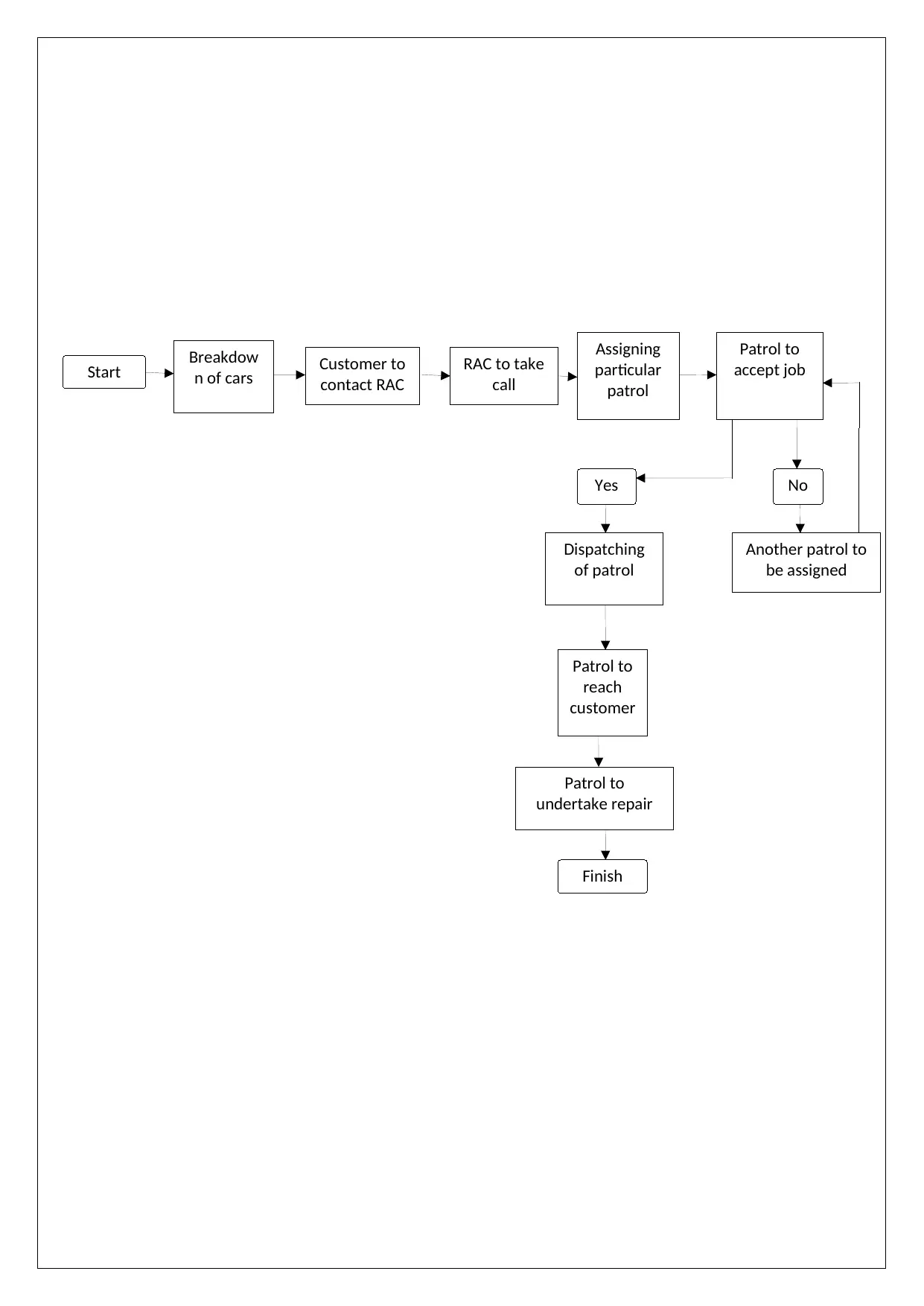
Customer to
contact RAC
RAC to take
call
Start Breakdow
n of cars
Assigning
particular
patrol
Patrol to
accept job
Yes No
Another patrol to
be assigned
Dispatching
of patrol
Patrol to
reach
customer
Patrol to
undertake repair
Finish
contact RAC
RAC to take
call
Start Breakdow
n of cars
Assigning
particular
patrol
Patrol to
accept job
Yes No
Another patrol to
be assigned
Dispatching
of patrol
Patrol to
reach
customer
Patrol to
undertake repair
Finish
⊘ This is a preview!⊘
Do you want full access?
Subscribe today to unlock all pages.

Trusted by 1+ million students worldwide
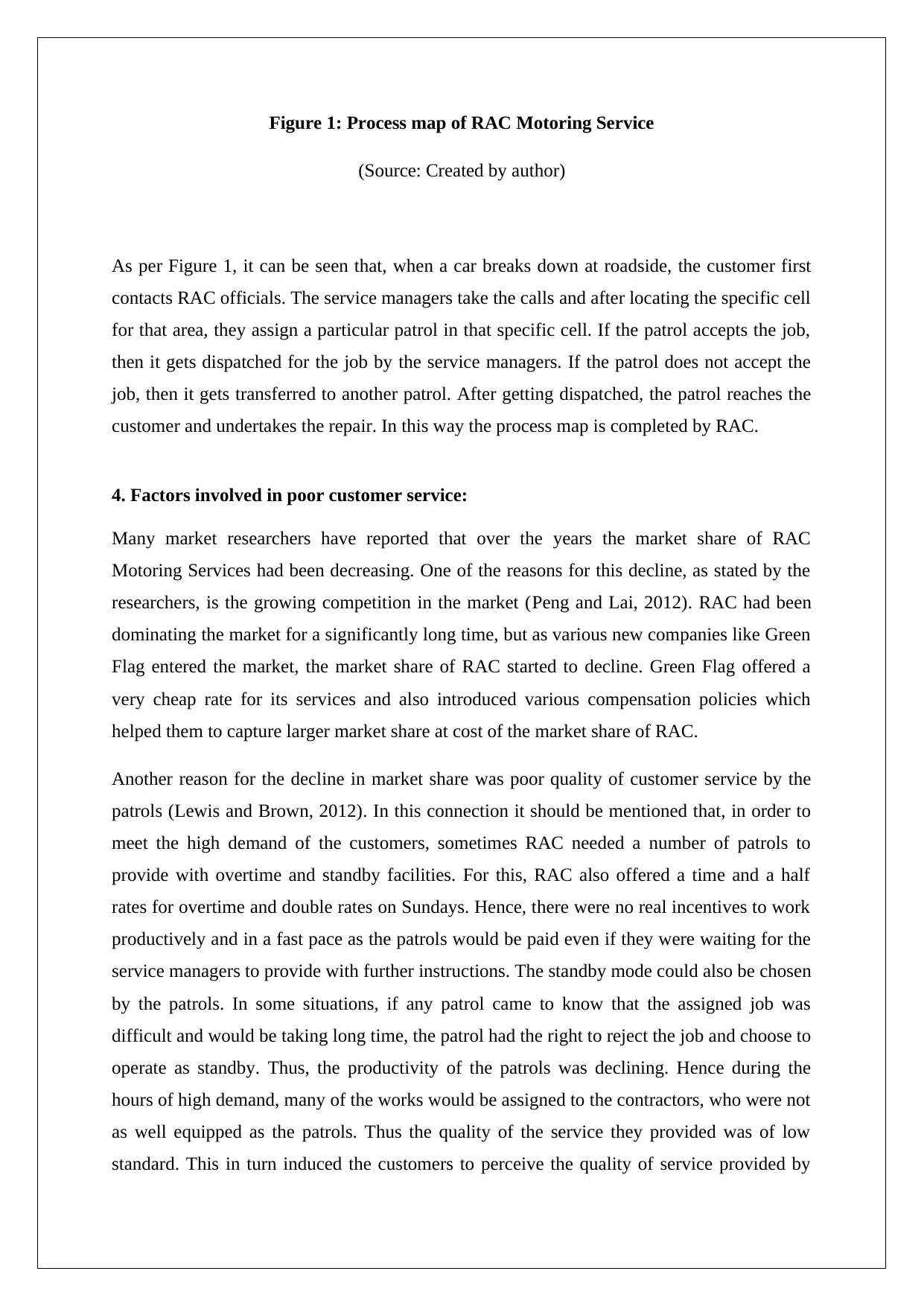
Figure 1: Process map of RAC Motoring Service
(Source: Created by author)
As per Figure 1, it can be seen that, when a car breaks down at roadside, the customer first
contacts RAC officials. The service managers take the calls and after locating the specific cell
for that area, they assign a particular patrol in that specific cell. If the patrol accepts the job,
then it gets dispatched for the job by the service managers. If the patrol does not accept the
job, then it gets transferred to another patrol. After getting dispatched, the patrol reaches the
customer and undertakes the repair. In this way the process map is completed by RAC.
4. Factors involved in poor customer service:
Many market researchers have reported that over the years the market share of RAC
Motoring Services had been decreasing. One of the reasons for this decline, as stated by the
researchers, is the growing competition in the market (Peng and Lai, 2012). RAC had been
dominating the market for a significantly long time, but as various new companies like Green
Flag entered the market, the market share of RAC started to decline. Green Flag offered a
very cheap rate for its services and also introduced various compensation policies which
helped them to capture larger market share at cost of the market share of RAC.
Another reason for the decline in market share was poor quality of customer service by the
patrols (Lewis and Brown, 2012). In this connection it should be mentioned that, in order to
meet the high demand of the customers, sometimes RAC needed a number of patrols to
provide with overtime and standby facilities. For this, RAC also offered a time and a half
rates for overtime and double rates on Sundays. Hence, there were no real incentives to work
productively and in a fast pace as the patrols would be paid even if they were waiting for the
service managers to provide with further instructions. The standby mode could also be chosen
by the patrols. In some situations, if any patrol came to know that the assigned job was
difficult and would be taking long time, the patrol had the right to reject the job and choose to
operate as standby. Thus, the productivity of the patrols was declining. Hence during the
hours of high demand, many of the works would be assigned to the contractors, who were not
as well equipped as the patrols. Thus the quality of the service they provided was of low
standard. This in turn induced the customers to perceive the quality of service provided by
(Source: Created by author)
As per Figure 1, it can be seen that, when a car breaks down at roadside, the customer first
contacts RAC officials. The service managers take the calls and after locating the specific cell
for that area, they assign a particular patrol in that specific cell. If the patrol accepts the job,
then it gets dispatched for the job by the service managers. If the patrol does not accept the
job, then it gets transferred to another patrol. After getting dispatched, the patrol reaches the
customer and undertakes the repair. In this way the process map is completed by RAC.
4. Factors involved in poor customer service:
Many market researchers have reported that over the years the market share of RAC
Motoring Services had been decreasing. One of the reasons for this decline, as stated by the
researchers, is the growing competition in the market (Peng and Lai, 2012). RAC had been
dominating the market for a significantly long time, but as various new companies like Green
Flag entered the market, the market share of RAC started to decline. Green Flag offered a
very cheap rate for its services and also introduced various compensation policies which
helped them to capture larger market share at cost of the market share of RAC.
Another reason for the decline in market share was poor quality of customer service by the
patrols (Lewis and Brown, 2012). In this connection it should be mentioned that, in order to
meet the high demand of the customers, sometimes RAC needed a number of patrols to
provide with overtime and standby facilities. For this, RAC also offered a time and a half
rates for overtime and double rates on Sundays. Hence, there were no real incentives to work
productively and in a fast pace as the patrols would be paid even if they were waiting for the
service managers to provide with further instructions. The standby mode could also be chosen
by the patrols. In some situations, if any patrol came to know that the assigned job was
difficult and would be taking long time, the patrol had the right to reject the job and choose to
operate as standby. Thus, the productivity of the patrols was declining. Hence during the
hours of high demand, many of the works would be assigned to the contractors, who were not
as well equipped as the patrols. Thus the quality of the service they provided was of low
standard. This in turn induced the customers to perceive the quality of service provided by
Paraphrase This Document
Need a fresh take? Get an instant paraphrase of this document with our AI Paraphraser
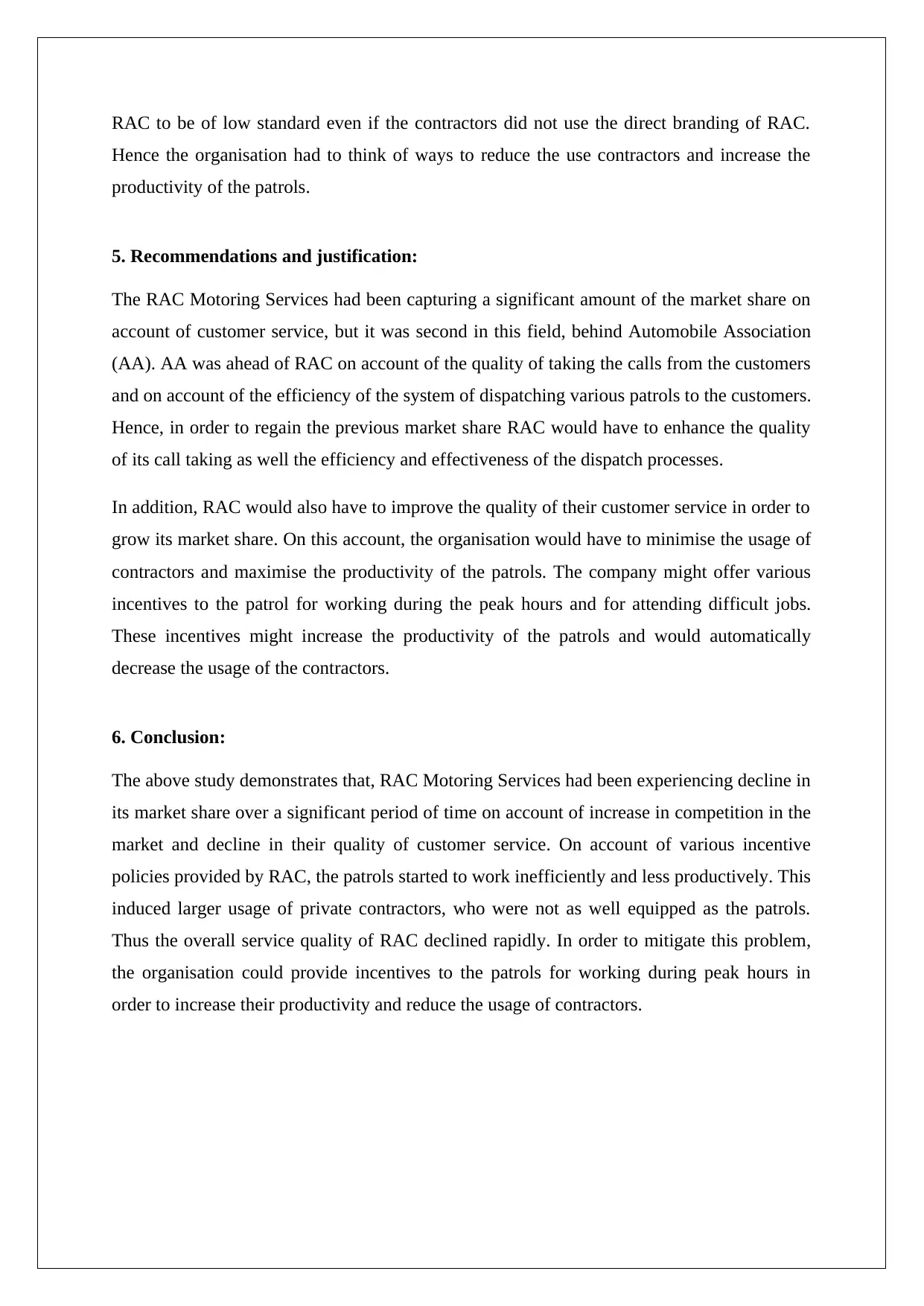
RAC to be of low standard even if the contractors did not use the direct branding of RAC.
Hence the organisation had to think of ways to reduce the use contractors and increase the
productivity of the patrols.
5. Recommendations and justification:
The RAC Motoring Services had been capturing a significant amount of the market share on
account of customer service, but it was second in this field, behind Automobile Association
(AA). AA was ahead of RAC on account of the quality of taking the calls from the customers
and on account of the efficiency of the system of dispatching various patrols to the customers.
Hence, in order to regain the previous market share RAC would have to enhance the quality
of its call taking as well the efficiency and effectiveness of the dispatch processes.
In addition, RAC would also have to improve the quality of their customer service in order to
grow its market share. On this account, the organisation would have to minimise the usage of
contractors and maximise the productivity of the patrols. The company might offer various
incentives to the patrol for working during the peak hours and for attending difficult jobs.
These incentives might increase the productivity of the patrols and would automatically
decrease the usage of the contractors.
6. Conclusion:
The above study demonstrates that, RAC Motoring Services had been experiencing decline in
its market share over a significant period of time on account of increase in competition in the
market and decline in their quality of customer service. On account of various incentive
policies provided by RAC, the patrols started to work inefficiently and less productively. This
induced larger usage of private contractors, who were not as well equipped as the patrols.
Thus the overall service quality of RAC declined rapidly. In order to mitigate this problem,
the organisation could provide incentives to the patrols for working during peak hours in
order to increase their productivity and reduce the usage of contractors.
Hence the organisation had to think of ways to reduce the use contractors and increase the
productivity of the patrols.
5. Recommendations and justification:
The RAC Motoring Services had been capturing a significant amount of the market share on
account of customer service, but it was second in this field, behind Automobile Association
(AA). AA was ahead of RAC on account of the quality of taking the calls from the customers
and on account of the efficiency of the system of dispatching various patrols to the customers.
Hence, in order to regain the previous market share RAC would have to enhance the quality
of its call taking as well the efficiency and effectiveness of the dispatch processes.
In addition, RAC would also have to improve the quality of their customer service in order to
grow its market share. On this account, the organisation would have to minimise the usage of
contractors and maximise the productivity of the patrols. The company might offer various
incentives to the patrol for working during the peak hours and for attending difficult jobs.
These incentives might increase the productivity of the patrols and would automatically
decrease the usage of the contractors.
6. Conclusion:
The above study demonstrates that, RAC Motoring Services had been experiencing decline in
its market share over a significant period of time on account of increase in competition in the
market and decline in their quality of customer service. On account of various incentive
policies provided by RAC, the patrols started to work inefficiently and less productively. This
induced larger usage of private contractors, who were not as well equipped as the patrols.
Thus the overall service quality of RAC declined rapidly. In order to mitigate this problem,
the organisation could provide incentives to the patrols for working during peak hours in
order to increase their productivity and reduce the usage of contractors.
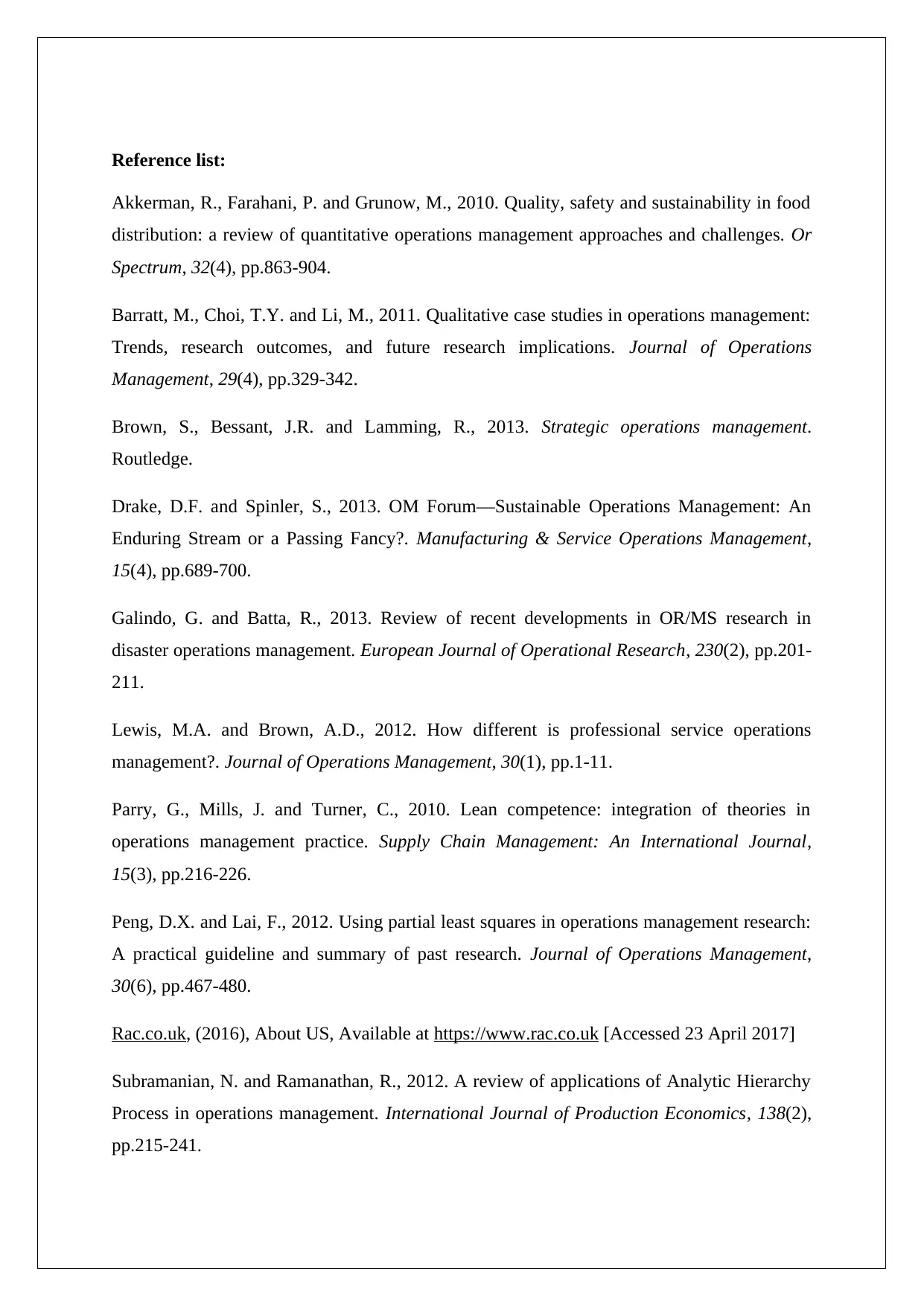
Reference list:
Akkerman, R., Farahani, P. and Grunow, M., 2010. Quality, safety and sustainability in food
distribution: a review of quantitative operations management approaches and challenges. Or
Spectrum, 32(4), pp.863-904.
Barratt, M., Choi, T.Y. and Li, M., 2011. Qualitative case studies in operations management:
Trends, research outcomes, and future research implications. Journal of Operations
Management, 29(4), pp.329-342.
Brown, S., Bessant, J.R. and Lamming, R., 2013. Strategic operations management.
Routledge.
Drake, D.F. and Spinler, S., 2013. OM Forum—Sustainable Operations Management: An
Enduring Stream or a Passing Fancy?. Manufacturing & Service Operations Management,
15(4), pp.689-700.
Galindo, G. and Batta, R., 2013. Review of recent developments in OR/MS research in
disaster operations management. European Journal of Operational Research, 230(2), pp.201-
211.
Lewis, M.A. and Brown, A.D., 2012. How different is professional service operations
management?. Journal of Operations Management, 30(1), pp.1-11.
Parry, G., Mills, J. and Turner, C., 2010. Lean competence: integration of theories in
operations management practice. Supply Chain Management: An International Journal,
15(3), pp.216-226.
Peng, D.X. and Lai, F., 2012. Using partial least squares in operations management research:
A practical guideline and summary of past research. Journal of Operations Management,
30(6), pp.467-480.
Rac.co.uk, (2016), About US, Available at https://www.rac.co.uk [Accessed 23 April 2017]
Subramanian, N. and Ramanathan, R., 2012. A review of applications of Analytic Hierarchy
Process in operations management. International Journal of Production Economics, 138(2),
pp.215-241.
Akkerman, R., Farahani, P. and Grunow, M., 2010. Quality, safety and sustainability in food
distribution: a review of quantitative operations management approaches and challenges. Or
Spectrum, 32(4), pp.863-904.
Barratt, M., Choi, T.Y. and Li, M., 2011. Qualitative case studies in operations management:
Trends, research outcomes, and future research implications. Journal of Operations
Management, 29(4), pp.329-342.
Brown, S., Bessant, J.R. and Lamming, R., 2013. Strategic operations management.
Routledge.
Drake, D.F. and Spinler, S., 2013. OM Forum—Sustainable Operations Management: An
Enduring Stream or a Passing Fancy?. Manufacturing & Service Operations Management,
15(4), pp.689-700.
Galindo, G. and Batta, R., 2013. Review of recent developments in OR/MS research in
disaster operations management. European Journal of Operational Research, 230(2), pp.201-
211.
Lewis, M.A. and Brown, A.D., 2012. How different is professional service operations
management?. Journal of Operations Management, 30(1), pp.1-11.
Parry, G., Mills, J. and Turner, C., 2010. Lean competence: integration of theories in
operations management practice. Supply Chain Management: An International Journal,
15(3), pp.216-226.
Peng, D.X. and Lai, F., 2012. Using partial least squares in operations management research:
A practical guideline and summary of past research. Journal of Operations Management,
30(6), pp.467-480.
Rac.co.uk, (2016), About US, Available at https://www.rac.co.uk [Accessed 23 April 2017]
Subramanian, N. and Ramanathan, R., 2012. A review of applications of Analytic Hierarchy
Process in operations management. International Journal of Production Economics, 138(2),
pp.215-241.
⊘ This is a preview!⊘
Do you want full access?
Subscribe today to unlock all pages.

Trusted by 1+ million students worldwide
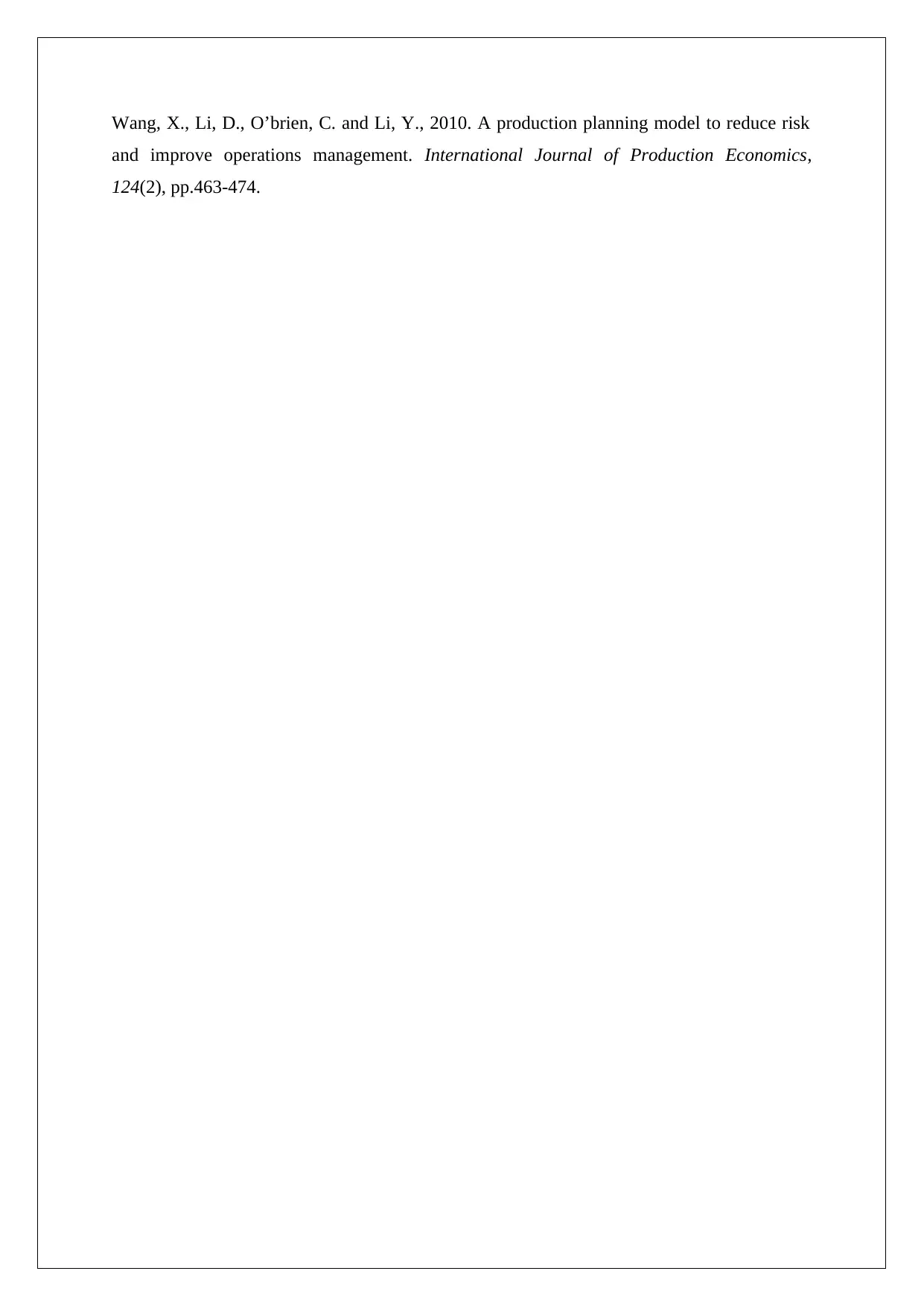
Wang, X., Li, D., O’brien, C. and Li, Y., 2010. A production planning model to reduce risk
and improve operations management. International Journal of Production Economics,
124(2), pp.463-474.
and improve operations management. International Journal of Production Economics,
124(2), pp.463-474.
1 out of 10
Related Documents
Your All-in-One AI-Powered Toolkit for Academic Success.
+13062052269
info@desklib.com
Available 24*7 on WhatsApp / Email
![[object Object]](/_next/static/media/star-bottom.7253800d.svg)
Unlock your academic potential
Copyright © 2020–2025 A2Z Services. All Rights Reserved. Developed and managed by ZUCOL.





